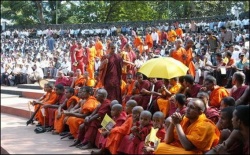Difference between revisions of "Memorization and Liturgical Discipline"
| Line 1: | Line 1: | ||
{{DisplayImages|2195|2456}} | {{DisplayImages|2195|2456}} | ||
| − | |||
| − | |||
| − | |||
| − | |||
| − | |||
| − | In the [[monastic]] [[universities]], liturgy plays a less important role (relatively {{Wiki|speaking}}). Accordingly, in these {{Wiki|institutions}} less [[time]] and [[effort]] are spent on memorizing liturgical material. Nevertheless, only after mastering this liturgy are [[monks]] admitted as full members of the [[monastery]], able to take part in {{Wiki|scholastic}} activities.9 Thus, memorization of liturgical texts is a basic practice of [[Tibetan | + | |
| + | |||
| + | by {{Wiki|Georges Dreyfus}} | ||
| + | |||
| + | |||
| + | |||
| + | |||
| + | Memorization is an important [[element]] of the disciplinary practices on which [[Tibetan]] [[monasticism]] rests. | ||
| + | |||
| + | It integrates [[monks]] into the [[monastic community]] by enabling them to take part in the [[monastery’s]] collective [[rituals]], which are its central [[activities]]. | ||
| + | |||
| + | On entering a [[monastery]], the young [[monk]] must first memorize its liturgy ([[chöchö]]), which is of two types. | ||
| + | |||
| + | The [[exoteric liturgy]] contains a few short [[sūtras]] (such as the [[Heart Sutra]]), confessional texts, [[prayers]] in the proper [[sense]] of the [[word]] ([[mönlam]]), and devotional practices such as the [[Seven-lim]]b {{Wiki|worship}}. | ||
| + | |||
| + | The [[esoteric liturgy]] comprises a large number of [[tantric texts]] as well as the texts necessary to propitiate the [[protectors]]. | ||
| + | |||
| + | |||
| + | |||
| + | The centrality of these [[liturgical practices]] varies from [[monastery]] to [[monastery]]. | ||
| + | |||
| + | In those specializing in [[liturgical services]], such as the [[Tantric]] [[Monasteries]] and [[Namgyel]], [[ritual]] is the main [[activity]]. | ||
| + | |||
| + | The [[liturgy]] of these [[monasteries]] includes hundreds of folios whose memorization requires several years of extremely demanding [[effort]]. | ||
| + | |||
| + | The [[knowledge]] of new [[monks]] is tested: on a number of occasions they must recite the entire [[liturgy]] of the [[monastery]] in front of their peers. | ||
| + | |||
| + | They are also sometimes examined privately by the higher authorities, who may deliberately disrupt the {{Wiki|recitation}} in order to see how deeply ingrained a [[monk’s]] memorization is. | ||
| + | |||
| + | |||
| + | A [[friend]] from Namgyel recalls that the [[Dalai Lama]] suddenly entered the room where he was reciting. | ||
| + | |||
| + | |||
| + | Not content with just listening to the {{Wiki|recitation}}, the [[Dalai Lama]] proceeded to scratch my friend’s back to test if his memorization was unshakable. | ||
| + | |||
| + | Despite the considerable [[emotion]] provoked by this gesture, my [[friend]] did not lose his [[concentration]] and was able to continue to recite flawlessly. | ||
| + | |||
| + | |||
| + | |||
| + | In smaller [[monasteries]] like [[Rgan Blo bzang rgya mtsho]]’s, the requirements are usually less stringent, and the [[life]] of a young [[monk]] memorizing the liturgy can be quite [[pleasant]], provided that his [[teacher]] is not too harsh. | ||
| + | |||
| + | By the age of seventeen (he had started at eleven), [[Genla]] had finished the first part of his task. | ||
| + | |||
| + | He had memorized the [[exoteric]] part of the liturgy, presumably together with the [[rituals]] of propitiation. | ||
| + | |||
| + | Having finished the bare minimum of memorization, he was ready to go on to the next step: a three-year visit to one of the three [[monastic]] seats. | ||
| + | |||
| + | |||
| + | |||
| + | In the [[monastic universities]], [[liturgy]] plays a less important role (relatively {{Wiki|speaking}}). | ||
| + | |||
| + | Accordingly, in these {{Wiki|institutions}} less [[time]] and [[effort]] are spent on memorizing [[liturgical]] material. | ||
| + | |||
| + | Nevertheless, only after mastering this [[liturgy]] are [[monks]] admitted as full members of the [[monastery]], able to take part in {{Wiki|scholastic}} activities.9 | ||
| + | |||
| + | Thus, memorization of [[liturgical texts]] is a basic practice of [[Tibetan monasticism]]. | ||
| + | |||
| + | Unlike [[scholarly]] training, which is undertaken only by a small minority through many years of intense [[dedication]], memorization is the province of all the [[monks]]. | ||
| + | |||
| + | It inculcates in them a [[sense of discipline]] central to the [[monastic]] enterprise as they follow a daily routine under the supervision of an authority. | ||
| + | |||
| + | They start the day with an assignment from their [[teacher]] and end it with the teacher’s examination of that same task. | ||
| + | |||
| + | This cannot help but greatly strengthen the [[sense]] of {{Wiki|obedience}} that young [[monks]] develop toward their [[teachers]] – a [[sense]] particularly reinforced by the ordeals of the daily examination, and the possible punishments associated with it. | ||
| + | |||
| + | But memorization’s most important disciplinary role is that it [[forms]] [[monks]] into efficient members of the [[ritual]] {{Wiki|community}}. | ||
| + | |||
| + | [[Rituals]] can be performed well only when they are properly memorized and recited uniformly by all [[monks]] to the same tune and rhythm. This uniformity creates a powerful effect that satisfies performers and supporters alike. | ||
| + | |||
| + | The [[monks]] can [[feel]] confident of the [[religious]] power or value of such practices, and sponsors, in turn, [[feel]] justified in their support of the [[monastery]]. | ||
| + | |||
| + | |||
[9] José Cabezón, “The Regulations of a [[Monastery]],” in [[Religions]] of [[Tibet]] in Practice, ed. Donald Lopez (Princeton: {{Wiki|Princeton University Press}}, 1997), 351 | [9] José Cabezón, “The Regulations of a [[Monastery]],” in [[Religions]] of [[Tibet]] in Practice, ed. Donald Lopez (Princeton: {{Wiki|Princeton University Press}}, 1997), 351 | ||
| − | + | ||
| + | |||
| + | |||
| + | |||
| + | |||
| + | |||
| + | |||
{{R}} | {{R}} | ||
[http://www.thlib.org/places/monasteries/sera/essays/#!essay=/dreyfus/drepung/monasticed/s/b23 www.thlib.org] | [http://www.thlib.org/places/monasteries/sera/essays/#!essay=/dreyfus/drepung/monasticed/s/b23 www.thlib.org] | ||
[[Category:Tibetan Monastic Education]] | [[Category:Tibetan Monastic Education]] | ||
Latest revision as of 05:02, 22 May 2019
Memorization is an important element of the disciplinary practices on which Tibetan monasticism rests.
It integrates monks into the monastic community by enabling them to take part in the monastery’s collective rituals, which are its central activities.
On entering a monastery, the young monk must first memorize its liturgy (chöchö), which is of two types.
The exoteric liturgy contains a few short sūtras (such as the Heart Sutra), confessional texts, prayers in the proper sense of the word (mönlam), and devotional practices such as the Seven-limb worship.
The esoteric liturgy comprises a large number of tantric texts as well as the texts necessary to propitiate the protectors.
The centrality of these liturgical practices varies from monastery to monastery.
In those specializing in liturgical services, such as the Tantric Monasteries and Namgyel, ritual is the main activity.
The liturgy of these monasteries includes hundreds of folios whose memorization requires several years of extremely demanding effort.
The knowledge of new monks is tested: on a number of occasions they must recite the entire liturgy of the monastery in front of their peers.
They are also sometimes examined privately by the higher authorities, who may deliberately disrupt the recitation in order to see how deeply ingrained a monk’s memorization is.
A friend from Namgyel recalls that the Dalai Lama suddenly entered the room where he was reciting.
Not content with just listening to the recitation, the Dalai Lama proceeded to scratch my friend’s back to test if his memorization was unshakable.
Despite the considerable emotion provoked by this gesture, my friend did not lose his concentration and was able to continue to recite flawlessly.
In smaller monasteries like Rgan Blo bzang rgya mtsho’s, the requirements are usually less stringent, and the life of a young monk memorizing the liturgy can be quite pleasant, provided that his teacher is not too harsh.
By the age of seventeen (he had started at eleven), Genla had finished the first part of his task.
He had memorized the exoteric part of the liturgy, presumably together with the rituals of propitiation.
Having finished the bare minimum of memorization, he was ready to go on to the next step: a three-year visit to one of the three monastic seats.
In the monastic universities, liturgy plays a less important role (relatively speaking).
Accordingly, in these institutions less time and effort are spent on memorizing liturgical material.
Nevertheless, only after mastering this liturgy are monks admitted as full members of the monastery, able to take part in scholastic activities.9
Thus, memorization of liturgical texts is a basic practice of Tibetan monasticism.
Unlike scholarly training, which is undertaken only by a small minority through many years of intense dedication, memorization is the province of all the monks.
It inculcates in them a sense of discipline central to the monastic enterprise as they follow a daily routine under the supervision of an authority.
They start the day with an assignment from their teacher and end it with the teacher’s examination of that same task.
This cannot help but greatly strengthen the sense of obedience that young monks develop toward their teachers – a sense particularly reinforced by the ordeals of the daily examination, and the possible punishments associated with it.
But memorization’s most important disciplinary role is that it forms monks into efficient members of the ritual community.
Rituals can be performed well only when they are properly memorized and recited uniformly by all monks to the same tune and rhythm. This uniformity creates a powerful effect that satisfies performers and supporters alike.
The monks can feel confident of the religious power or value of such practices, and sponsors, in turn, feel justified in their support of the monastery.
[9] José Cabezón, “The Regulations of a Monastery,” in Religions of Tibet in Practice, ed. Donald Lopez (Princeton: Princeton University Press, 1997), 351

